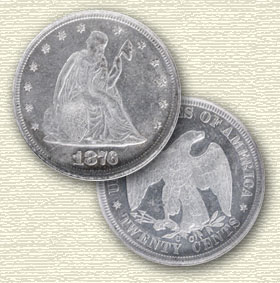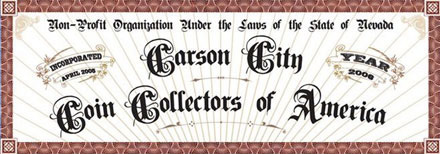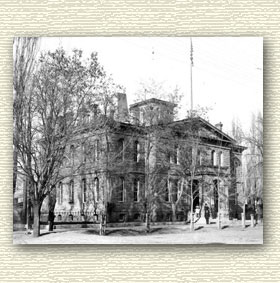- Posts: 614
- Thank you received: 0
1872-CC Seated Quarter CC Coin of the Week - 1-09-2011
Less
More
14 years 9 months ago - 14 years 9 months ago #1795
by Garryn
1872-CC Seated Quarter CC Coin of the Week - 1-09-2011 was created by Garryn
1872 was the third full year of activity at the Carson City Mint. The Mint seemed to be still in a transitional state, feeling its way thru the processes. However, the face value of coinage produced there, at $876,725 came the closest to the $1,000,000 mark until 1874 when $1.3 million in trade dollars were produced and the Mint operated full steam. 1872 quarter production reached 9,100 examples.
This is not a coin for the faint hearted. There are probably very few itchy trigger fingers when a specimen comes up for bid. Rusty Goe estimates that 55 to 70 exist in all grades, with 3 estimated in uncirculated condition and 6 to7 in EF thru AU.
Rusty Goe also reports in "The Mint on Carson Street" that the Eliasberg specimen at MS66 is far and away the finest known example of this date and mint mark. Dave Bowers in his catalog description described it as “far and away the finest known to exist.” Louis E. Eliasberg obtained this coin when he purchased the John H. Clapp collection in February, 1942. Mr. Eliasberg paid $101,000 for the entire collection, including duplicates. The duplicates were sold by Stack’s in October of the same year. If any of our readers obtained Stack’s Philadelphia Americana Sale catalog for the auction that occurred September 30 thru October 2, 2010, you know that the Clapp collection was appraised independently by three numismatists. John Zug provided an appraisal of $130,006.15. Wayte Raymond and James Macalister provided a joint appraisal totaling $128,038. The appraisals were done coin by coin on approximately 250 legal size pages. The appraisal was then summarized by denomination. There were 682 quarters in the collection. Zug estimated the value at $3,984.75 and Raymond and Macallister estimated the value at $3,824. Per coin, the average value comes to $5.75 and $5.61. Out of that group of quarters came major condition census rarities, including the MS-66 1872-CC.
I introduced this article by stating that the1872-CC was not a coin for the faint hearted. It would be quite a coup if all the known specimens, EF thru uncirculated were owned by C4OA members.
This is not a coin for the faint hearted. There are probably very few itchy trigger fingers when a specimen comes up for bid. Rusty Goe estimates that 55 to 70 exist in all grades, with 3 estimated in uncirculated condition and 6 to7 in EF thru AU.
Rusty Goe also reports in "The Mint on Carson Street" that the Eliasberg specimen at MS66 is far and away the finest known example of this date and mint mark. Dave Bowers in his catalog description described it as “far and away the finest known to exist.” Louis E. Eliasberg obtained this coin when he purchased the John H. Clapp collection in February, 1942. Mr. Eliasberg paid $101,000 for the entire collection, including duplicates. The duplicates were sold by Stack’s in October of the same year. If any of our readers obtained Stack’s Philadelphia Americana Sale catalog for the auction that occurred September 30 thru October 2, 2010, you know that the Clapp collection was appraised independently by three numismatists. John Zug provided an appraisal of $130,006.15. Wayte Raymond and James Macalister provided a joint appraisal totaling $128,038. The appraisals were done coin by coin on approximately 250 legal size pages. The appraisal was then summarized by denomination. There were 682 quarters in the collection. Zug estimated the value at $3,984.75 and Raymond and Macallister estimated the value at $3,824. Per coin, the average value comes to $5.75 and $5.61. Out of that group of quarters came major condition census rarities, including the MS-66 1872-CC.
I introduced this article by stating that the1872-CC was not a coin for the faint hearted. It would be quite a coup if all the known specimens, EF thru uncirculated were owned by C4OA members.
Last edit: 14 years 9 months ago by Garryn.
Please Log in to join the conversation.
14 years 9 months ago #1796
by Belayoff
C4OA Lifer!
Replied by Belayoff on topic Re:1872-CC Seated Quarter CC Coin of the Week - 1-09-2011
Garryn,
The Eliasberg saga and those of the major collectors before him are fascinating, particularly in one aspect. These guys lived in a world of glacial speed communications and had to inspect coins slowly, one at a time by postal mail or hand carried packages. Can you imagine the patients and perseverance it required to build these revered and historically important collections?
The quality of the Eliasberg collection was only partially due to his financial capabilities. This gentleman was the quintessential "Knowledge Based Collector" at a time when there was almost no supportive, written information about what aspects made up a true quality coin. It is no accident that the name Eliasberg is synonymous with the term "PQ" (premium quality).
You certainly are right about the difficulty of collecting the 1872-CC quarter. This coin is a monster in almost any grade. I am very fortunate to own two examples, albeit at the modest grades of VF-25 and VG-8.
Belay Off
The Eliasberg saga and those of the major collectors before him are fascinating, particularly in one aspect. These guys lived in a world of glacial speed communications and had to inspect coins slowly, one at a time by postal mail or hand carried packages. Can you imagine the patients and perseverance it required to build these revered and historically important collections?
The quality of the Eliasberg collection was only partially due to his financial capabilities. This gentleman was the quintessential "Knowledge Based Collector" at a time when there was almost no supportive, written information about what aspects made up a true quality coin. It is no accident that the name Eliasberg is synonymous with the term "PQ" (premium quality).
You certainly are right about the difficulty of collecting the 1872-CC quarter. This coin is a monster in almost any grade. I am very fortunate to own two examples, albeit at the modest grades of VF-25 and VG-8.
[img size=400]
i788.photobucket.com/albums/yy166/BelayO...rter-1872-pcgs25.jpg
[/IMG size=400]
1872-CC 25c VF-25 PCGS
From the Rians Bequeath Carson City Collection
Belay Off
C4OA Lifer!
Please Log in to join the conversation.
- Loosechange
- Offline
- Platinum Member
-

- Married to my best friend!
Less
More
- Posts: 504
- Thank you received: 0
14 years 9 months ago #1797
by Loosechange
Go "CC'S"
Replied by Loosechange on topic Re:1872-CC Seated Quarter CC Coin of the Week - 1-09-2011
Excellent article Garryn ! I echo the words of Belay Off that the great collectors of the past were an enormous part of what we seek in our own collections today. I am fortunate to be able my to view such rarities and share the stories with the membership of this great club. Belay you have one beautiful rare coin shown in the picture,but to be the custodian of two such rarities is to me unbelievable. It is hard to imagine the 1872-CC quarter in a high grade considering such a low mintage. WOW !
Loosechange
Loosechange
Go "CC'S"
Please Log in to join the conversation.
14 years 9 months ago #1798
by Carsonite
C4OA Lifer!
Replied by Carsonite on topic Re:1872-CC Seated Quarter CC Coin of the Week - 1-09-2011
GarryN,
You wrote:
Thanks again for your ongoing contributions to this discussion board forum.
Rusty
You wrote:
You tied these important statistics together with your 1872-CC quarter profile to make an interesting observation. The use of historical pricing information helps us keep present-day coin values in proper perspective.The appraisal was then summarized by denomination. There were 682 quarters in the collection. Zug estimated the value at $3,984.75 and Raymond and Macallister estimated the value at $3,824. Per coin, the average value comes to $5.75 and $5.61. Out of that group of quarters came major condition census rarities, including the MS-66 1872-CC.
Thanks again for your ongoing contributions to this discussion board forum.
Rusty
C4OA Lifer!
Please Log in to join the conversation.
Less
More
- Posts: 614
- Thank you received: 0
14 years 9 months ago - 14 years 9 months ago #1801
by Garryn
Replied by Garryn on topic Re:1872-CC Seated Quarter CC Coin of the Week - 1-09-2011
Thanks for pointing that out. At that time, the descriptive information in auction catalogs was next to nothing. So buyers were going on gut feeling. A few years ago I purchased a small Turkish gold coin that was part of the Eliasberg collection and was also pedigreed to Thomas Voetter, a US diplomat to South America who sold his collection via Max Mehl in 1943. When the 2010 Philadelphia Americana sale was conducted, a number of Eliasberg's papers were sold. I was very fortunate to win the catalog and price realized list from the Voetter collection that includes Eliasberg's notes. So that is a cool link to have. But the point is that he picked out coins based on brief and austere descriptions. And he had the foresight, like the Clapp family before him and unlike others, to leave the coins alone and protect them.
Also until recently, quality photographs were few and far between. For example, I have the Harry Bass Museum Sylloge. This is a compendium of all Harry Bass's gold coins, patterns and currency put together by Dave Bowers, not that long ago. There are many photos in there, supposedly. But the photos of the gold coins look more like drawings than photos. Certainly not plate quality. On the other hand, the photos of the currency are very well done.
Also until recently, quality photographs were few and far between. For example, I have the Harry Bass Museum Sylloge. This is a compendium of all Harry Bass's gold coins, patterns and currency put together by Dave Bowers, not that long ago. There are many photos in there, supposedly. But the photos of the gold coins look more like drawings than photos. Certainly not plate quality. On the other hand, the photos of the currency are very well done.
Last edit: 14 years 9 months ago by Garryn.
Please Log in to join the conversation.
Less
More
- Posts: 614
- Thank you received: 0
14 years 9 months ago #1802
by Garryn
Replied by Garryn on topic Re:1872-CC Seated Quarter CC Coin of the Week - 1-09-2011
Thanks for your comments, Rusty. I was reading the appraisal summary in the catalog with a 10x loupe !! :laugh:
Please Log in to join the conversation.
Time to create page: 0.115 seconds


